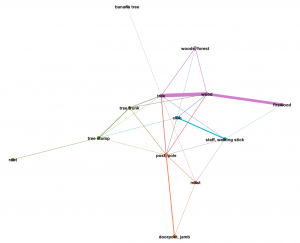 A semantic map is a common method in semantic typology to detect cross-linguistic regularities and recurrent patterns in semantic structure. Additionally, it is used as a heuristic technique to analyze the multiple senses of linguistic units in the languages of the world, as well as their possible meaning extensions (see, e.g., Haspelmath 2003; Cysouw et al. 2010).
A semantic map is a common method in semantic typology to detect cross-linguistic regularities and recurrent patterns in semantic structure. Additionally, it is used as a heuristic technique to analyze the multiple senses of linguistic units in the languages of the world, as well as their possible meaning extensions (see, e.g., Haspelmath 2003; Cysouw et al. 2010).
Based on cross-linguistic polysemy data, one can infer a graph of connected senses (the nodes of the graph). There is a single constraint for plotting semantic maps: all the linguistic items, when mapped onto the graph, must cover a connected region (this is known as the connectivity hypothesis; see Croft 2001).
The figure on the right is an illustration of lexical semantic map with weighted edges. In order to plot this map, we processed data from CLICS for 13 meanings connected to the senses ‘tree’ and ‘wood’. We ended up with 245 ‘words’ in 168 languages expressing more than one of these 13 meanings. It is then possible to plot a map for the 13 meanings that respects the connectivity hypothesis. This means that each word of the data sample will cover a connected region of the graph.
Furthermore, this map is weighted: the thickness of the edges between the nodes depends directly on the frequency of a polysemy pattern. For instance, it shows that words expressing at the same time the meanings ‘tree’ and ‘wood’ (thick line) are much more frequent than the ones expressing simultaneously ‘tree’ and ‘woods, forest’ (thin line).